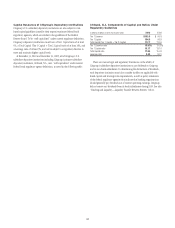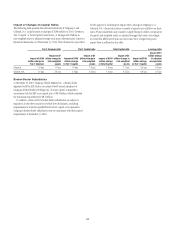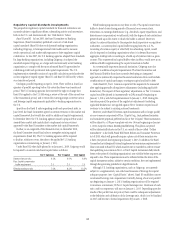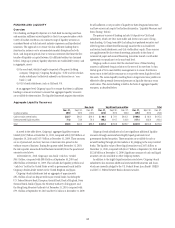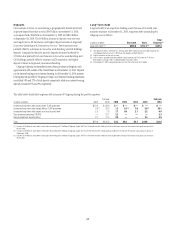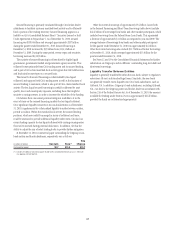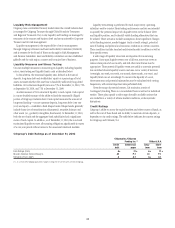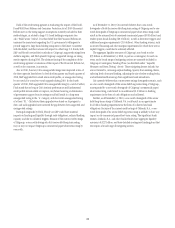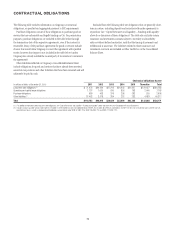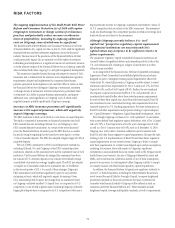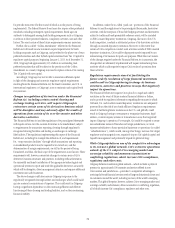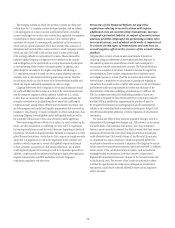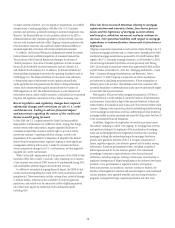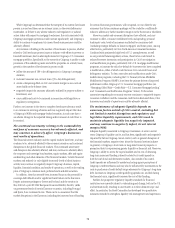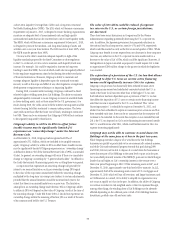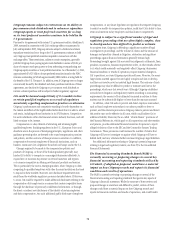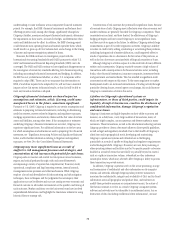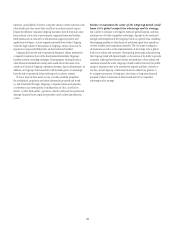Citibank 2010 Annual Report Download - page 73
Download and view the complete annual report
Please find page 73 of the 2010 Citibank annual report below. You can navigate through the pages in the report by either clicking on the pages listed below, or by using the keyword search tool below to find specific information within the annual report.71
RISK FACTORS
The ongoing implementation of the Dodd-Frank Wall Street
Reform and Consumer Protection Act of 2010 will require
Citigroup to restructure or change certain of its business
practices and potentially reduce revenues or otherwise
limit its profitability, including by imposing additional
costs on Citigroup, some of which may be significant.
The Dodd-Frank Wall Street Reform and Consumer Protection Act of 2010
(Financial Reform Act), signed into law on July 21, 2010, calls for significant
structural reforms and new substantive regulation across the financial
industry. Because most of the provisions of the Financial Reform Act that
could particularly impact Citi are currently or will be subject to extensive
rulemaking and interpretation, a significant amount of uncertainty remains
as to the ultimate impact of the Financial Reform Act on Citigroup, especially
when combined with other ongoing U.S. and global regulatory developments.
This uncertainty impedes future planning with respect to certain of Citi’s
businesses and, combined with the extensive and comprehensive regulatory
requirements adopted and implemented in compressed time frames,
presents operational and compliance costs and risks. What is certain is that
the Financial Reform Act will require Citigroup to restructure, transform
or change certain of its business activities and practices, potentially limit
or eliminate Citi’s ability to pursue business opportunities, and impose
additional costs, some significant, on Citigroup, each of which could
negatively impact, possibly significantly, Citigroup’s earnings.
Increases in FDIC insurance premiums will significantly
increase Citi’s required premiums, which will negatively
impact Citigroup’s earnings.
The FDIC maintains a fund out of which it covers losses on insured deposits.
The fund is composed of assessments on financial institutions that hold
FDIC-insured deposits, including Citibank, N.A. and Citigroup’s other
FDIC-insured depository institutions. As a result of the recent financial
crisis, the Financial Reform Act seeks to put the FDIC fund on a sounder
financial footing by requiring that the fund have assets equal to at least
1.35% of insurable deposits. The FDIC has adopted a higher target of 2.0% of
insurable deposits.
The cost of FDIC assessments to FDIC-insured depository institutions,
including Citibank, N.A. and Citigroup’s other FDIC-insured depository
institutions, depends on the assessment rate and the assessment base of each
institution. The Financial Reform Act changed the assessment base from
the amount of U.S. domestic deposits to the amount of worldwide average
consolidated total assets less average tangible equity. The FDIC has adopted
a complex set of calculation rules for its assessment rate, to be effective
in the second quarter of 2011. As a result of these changes, Citigroup’s
FDIC assessments could increase significantly (prior to any potential
mitigating actions), which will negatively impact its earnings. Given
Citi’s substantial global footprint, the change from an assessment based
on Citigroup’s relatively smaller U.S. deposit base, as compared to its U.S.
competitors, to one related to global assets (including Citigroup’s relatively
larger global deposit base as compared to its U.S. competitors) will cause a
disproportionate increase in Citigroup’s assessment base relative to many of
its U.S. competitors that are subject to the FDIC assessment. The assessment
could also disadvantage Citi’s competitive position in relation to foreign local
banks which are not subject to the assessment.
Although Citigroup currently believes it is “well
capitalized,” prospective regulatory capital requirements
for financial institutions are uncertain and Citi’s
capitalization may not prove to be sufficient relative to
future requirements.
The prospective regulatory capital standards for financial institutions are
currently subject to significant debate and rulemaking activity, both in the
U.S. and internationally, resulting in a degree of uncertainty as to their
ultimate scope and effect.
As an outgrowth of the financial crisis, the Basel Committee on Banking
Supervision (Basel Committee) has established global financial reforms
designed, in part, to strengthen existing capital requirements (Basel III).
Under Basel III, when fully phased in, Citigroup would be subject to stated
minimum capital ratio requirements for Tier 1 Common of 4.5%, for Tier 1
Capital of 6.0%, and for Total Capital of 8.0%. Further, the new standards
also require a capital conservation buffer of 2.5%, and potentially also a
countercyclical capital buffer, above these stated minimum requirements
for each of these three capital tiers. Apart from risk-based capital, Basel III
also introduced a more constrained Leverage ratio requirement than that
currently imposed on U.S. banking organizations. For more information on
Basel III and other requirements and proposals relating to capital adequacy,
see “Capital Resources—Regulatory Capital Standards Developments” above.
Even though Citigroup continues to be “well capitalized” in accordance
with current federal bank regulatory agency definitions, with a Tier 1 Capital
ratio of 12.9%, a Total Capital ratio of 16.6%, and a Leverage ratio of 6.6%,
as well as a Tier 1 Common ratio of 10.8%, each as of December 31, 2010,
Citigroup may not be able to maintain sufficient capital consistent with
Basel III and other future regulatory capital requirements. Because the rules
relating to the U.S. implementation of Basel III and other future regulatory
capital requirements are not entirely certain, Citigroup’s ability to comply
with these requirements on a timely basis depends upon certain assumptions,
including, for instance, those with respect to Citigroup’s significant
investments in unconsolidated financial entities (such as the Morgan Stanley
Smith Barney joint venture), the size of Citigroup’s deferred tax assets and
MSRs, and its internal risk calibration models. If any of these assumptions
proves to be incorrect, it could negatively affect Citigroup’s ability to comply
in a timely manner with these future regulatory capital requirements.
In addition, the Financial Reform Act grants new regulatory authority to
various U.S. federal regulators, including the Federal Reserve Board and a
newly created Financial Stability Oversight Council, to impose heightened
prudential standards on financial institutions that pose a systemic risk
to market-wide financial stability (Citigroup will be defined as such an
institution under the Financial Reform Act). These standards include
heightened capital, leverage and liquidity standards, as well as requirements


